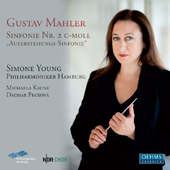
ESSENTIAL RECORDINGS

This is definitely a cut to the chase interpretation of this epic symphony. Conductor Simone Young doesn't languish, doesn't wallow
in sentimentality, doesn't emphasize or over-stretch any particular segment in self-indulgence nor to impress. If you compare timings with the famous
Bernstein/New York live recording on Deutsche Grammophon, Young stands at 79:27 compared to Bernstein's 93:28. As a matter of fact, she takes
only 3 extra seconds over the other iconic Klemperer/Philharmonia recording for EMI which sits at 79:24. It's more of a "if I have to die to get to heaven, let's get to it" approach.
Not to say that this sounds like a "let's get this over with" performance. Far from it. It's just streamlined, and better proportioned. Plus it fits on only one CD instead of the usual two. Bonus!
For example, at the 5:20 mark of the first movement where Gustav Mahler gives us a first glimpse at the heaven-to-be of the final
movement, following a nervously taut Allegro introduction, Simone Young ushers in that vision as beautifully as I've heard before. It is
characterized by a subtle fragility, as if the dream could easily be shattered. After a more vehement reappearance of the anger from the symphony's
first page, the 11:15 point marks the beginning of the funeral march proper, and this is where Young keeps everyone in line and everything moving. And
that urgency seems to help emphasize those great shattering moments along the way. At 15:40 heaven returns, more clearly defined, more attainable this time around.
The movement ends with the casket being lowered into the cold ground with a brutal effect of finality.
The second Andante moderato movement is beautifully shaped, with finely balanced levels of lyricism and drama. The members of the Hamburg Philharmonic Orchestra
easily demonstrate that even large orchestras can move their weight around as if in ballet slippers. It is played very much in the style of an Austrian
pastoral lšndler, a perfect counterweight to the first movement.
The central scherzo movement forms the pivotal point of the symphony. Like a disjointed waltz it brings to the dance floor all the conflicting elements
of the symphony, from the macabre major/minor modulations of the first movement to sudden outbursts of heavenly brass choirs, and all the comical
aspects of simple rural life thrown in for good measure. It all leads to a fierce display of anger at the 8:28 mark quickly appeased by yet another glimpse
at heaven. All these conflicting elements are well proportioned by Young and very well characterized by each individual instrumentalist in the orchestra.
The Urlicht fourth movement is where the conductor and alto Dagmar PeckovŠ could have slowed down the momentum a little. Mind you,
the off-stage brass is well done, the sound of the cellos, violas and english horn is rapt in its stillness, and the singer's voice is fine. But this is where the music begs for
patience, where each note has to be expressed in full, where even the rests have to be felt. Those opening notes, where the singer ascends from D to F-sharp, hold within
them the essence of the whole symphony, but here they fall just short of conveying that. And because we have been spoiled in the past by some great voices,
I find Dagmar PeckovŠ's voice slightly lacking at the bottom end, and not tenebrous enough for this music. But I am probably being too exacting here on such small points.
A great cry of anger opens the final movement, very well projected here, and the mysterious unfolding of the music that follows is even better, with the
off-stage horn, harp and muffled percussion all doing a great job to set the tone. The dark brass choir at 6:05 that begins the first ascent is well done,
and at 7:10, when the first full revelation of heaven takes place, the orchestra opens up like a rose in full bloom and shows all its brilliant colors. The rising
of the dead and march to the final judgement are resolute and devastating in their power. At the point where the NDR Choir enters,
Simone Young slows things down appropriately, allowing the harmonic beauty of those wonderful chords to unfold and lead into soprano Michaela
Kaune's uplifting entrance. Unfortunately, the rest of the movement is not always of equal merit. There are a few uneven ensemble entries from
within the choir, the alto's voice is sometimes overpowered and almost drowned out, and some of the changes in tempo velocities are too pronounced.
But then some of the string tones that emanate from the orchestra are wonderful, the sonic quality and impact of the choir as it increases in volume seems to improve
at every step, and the sense of urgency in the music is well conveyed. The dramatic "Bereite dich zu leben!" line for choir and alto is superbly
done, and more than makes up for their preceding line "HŲr' auf zu beben!" which is uneven. The final few minutes provide the expected
impact and power, especially from the orchestra, which easily overpowers the pipe organ and bells.
This is a prime example of a monumental symphonic work that requires an arduous effort on the part of everyone involved in its creation. And even though there
are moments here and there in this recording that are not quite up to my overly demanding standards, I would still grade everyone 110% for that effort.
Jean-Yves Duperron - March 2012